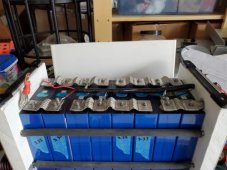Constant pressure is exactly what you want according to the data sheet. Not enough pressure allows the electrolyte to move too, and too much pressure gives the electrolyte nowhere to go when it changes size. The electrolyte *will* change size with state of charge in LFP chemistry.
Exactly. Within a very small range of movement, springs are
roughly constant (doing slightly more pressure when cells have expanded, and slightly less when they "shrink" in comparison to the original compression values and cell sizes). ANY kind of un-sprung box (including a "pretty" aluminum one) will apply NO FORCE AT ALL, when cells have shrunk away from the fixed-position sides, and very likely FAR TOO MUCH when expansion begins to press the cells into the non-yielding sides.
With springs, you have an area of "acceptable variation" while the moving sides vary the amount of spring compression. This variation in pack width, causing face pressure between 12-17 PSI, is the "working length" of your springs in the construction of a properly built LFP compression pack. Short springs, with high "ratings" (additional pounds per inch) will have very short working lengths. Longer springs will have longer working lengths, with less change in pressure per milimeter of spring length change.
But a box without springs provides no working length at all. When the cells are too "shrunk", the pressure is very low (and the cells may even flop around, rubbing against each other in an uncontrolled way). Then when the cells begin to expand, there will be just one TINY INSTANT while the expansion amount has matched the desired range. But any further expansion causes the cells to experience excessive pressure
It's just like using compression springs above their maximum rating, when they have completely bottomed out to "solid" height: The amount of additional pressure which is being applied, by the "solid spring" pushed past its maximum rating, reaches whatever force is being applied - with zero compensation.
Near constant pressure is the goal. Properly chosen and installed springs can come pretty close to providing that, and a solid box absolutely cannot.




